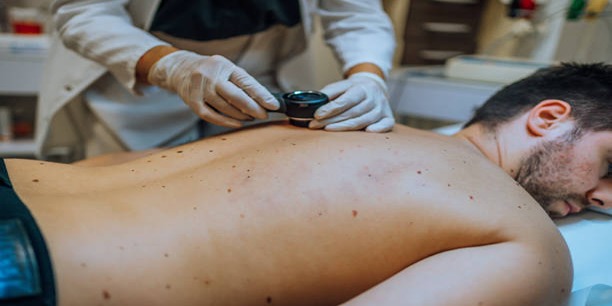Melanoma is one of the most serious forms of skin cancer, capable of rapid spread throughout the body if not detected early. The ABCDE rule stands as a critical guide for both healthcare professionals and individuals for the early detection of Melanoma through the examination of moles and skin changes. Recognizing the warning signs through this simple acronym can aid in early intervention and significantly improve treatment outcomes. This guide aims to provide an in-depth understanding of each aspect of the ABCDE rule, empowering you with the knowledge to monitor your skin effectively and seek medical advice when necessary. It is an essential component of proactive health management, given the rising incidence of Melanoma worldwide.
What is Melanoma?

Melanoma is a type of skin cancer that originates in the cells responsible for producing melanin, the pigment that gives our skin its color. Melanin-producing cells are called melanocytes, and when they become damaged or grow abnormally, it can lead to the development of Melanoma. This type of cancer typically occurs on the surface of the skin but can also form in other areas such as the eyes, mouth, or genitals. It is important to note that Melanoma can occur in individuals of any skin tone and even on areas of the body not typically exposed to sunlight.
Causes of Melanoma
The primary cause of Melanoma is exposure to ultraviolet (UV) radiation from the sun or artificial sources like tanning beds. Prolonged UV exposure can damage the DNA in skin cells, causing genetic mutations that lead to cancerous growths. Other risk factors for developing Melanoma include a personal or family history of skin cancer, a weakened immune system, and certain genetic conditions.
ABCDE Rules Explained
The ABCDE rule serves as a helpful tool for identifying potential warning signs of Melanoma. Each letter represents a distinct characteristic to look out for when examining moles or skin changes.
A is for Asymmetry
One of the first signs to watch for when examining a mole is asymmetry. A benign mole typically has a symmetrical shape, meaning if you were to draw a line through the middle, the two halves would mirror each other. In contrast, a mole that is asymmetrical displays mismatched halves. It's an important early warning sign when one side of the mole does not match the other and could indicate the possibility of Melanoma. Therefore, when checking your moles, take note of their overall shape and look for any irregularities in symmetry that could raise a red flag for further examination by a healthcare professional.
B is for Border
The border or edges of a mole can also provide valuable information on whether it could be Melanoma. Benign moles typically have smooth, even borders, while an early melanoma may have uneven or ragged edges. In some cases, the border of a melanoma may appear blurred and difficult to define. Pay attention to the border of your moles and make a note of any irregularities that may require further investigation.
C is for Color
The color of a mole can also provide clues about its potential to be Melanoma. Most benign moles are uniform in color, often brown or black. However, if you notice multiple colors within a single mole or variations in shade, it could be a warning sign of Melanoma. This type of mole may have areas that are red, white, blue, or other shades of brown. Additionally, melanomas can appear without any color at all and may be pink or skin-colored. Any significant change in the color of a mole should be monitored closely.
D is for Diameter
When assessing the size of moles, diameter is a key factor. Benign moles are usually smaller in size, typically less than 6 millimeters in diameter, which is roughly the size of a pencil eraser. Moles that are larger than this size may be a cause for concern and should be evaluated by a healthcare professional. It's crucial to monitor any moles that grow in size, as this could be an indication of melanoma development. Remember that some melanomas may be smaller when first detected, so any new moles or growths should also be assessed, especially if they have other concerning characteristics outlined by the ABCDE rule.
E is for Evolution
The evolution or change in a mole over time is another critical factor to consider when assessing for Melanoma. While most benign moles remain relatively stable, any significant changes in size, shape, color, or texture can be warning signs of Melanoma. It's essential to keep track of any changes in your moles and consult with a healthcare professional if you notice any unusual evolution. Additionally, pay attention to moles that become itchy, painful or start to bleed as these are also potential signs of Melanoma.
How to Check Your Moles?

Regularly checking your skin and moles is an important step in early detection of Melanoma. The best time to perform a self-examination is after a shower or bath, as your skin will be warm, relaxed, and easier to examine. Using both a full-length mirror and a handheld mirror can help you thoroughly check all areas of your body, including difficult-to-see areas like your back, scalp.
What to Look For?
When examining your skin for Moles, use the ABCDE rule as a guide. In addition to this, keep an eye out for any new moles or growths that may develop over time. It's also important to note if any of your existing moles start to change in size, shape, color, or texture. Any of these changes should be monitored closely and evaluated by a healthcare professional if necessary. Remember, early detection is key in effectively treating Melanoma.
Conclusion
Understanding the ABCDE rule is a crucial step in monitoring your skin for any potential signs of Melanoma. By regularly checking your skin and moles, you can catch any warning signs early on and seek appropriate medical care. Practicing sun safety measures such as wearing sunscreen, protective clothing, and avoiding tanning beds can also help reduce your risk of developing Melanoma. If you notice any concerning changes in your moles or skin, consult with a healthcare professional for further evaluation and guidance. Remember, early detection and prevention are key in protecting yourself against Melanoma. Stay vigilant and take care of your skin to stay healthy.







